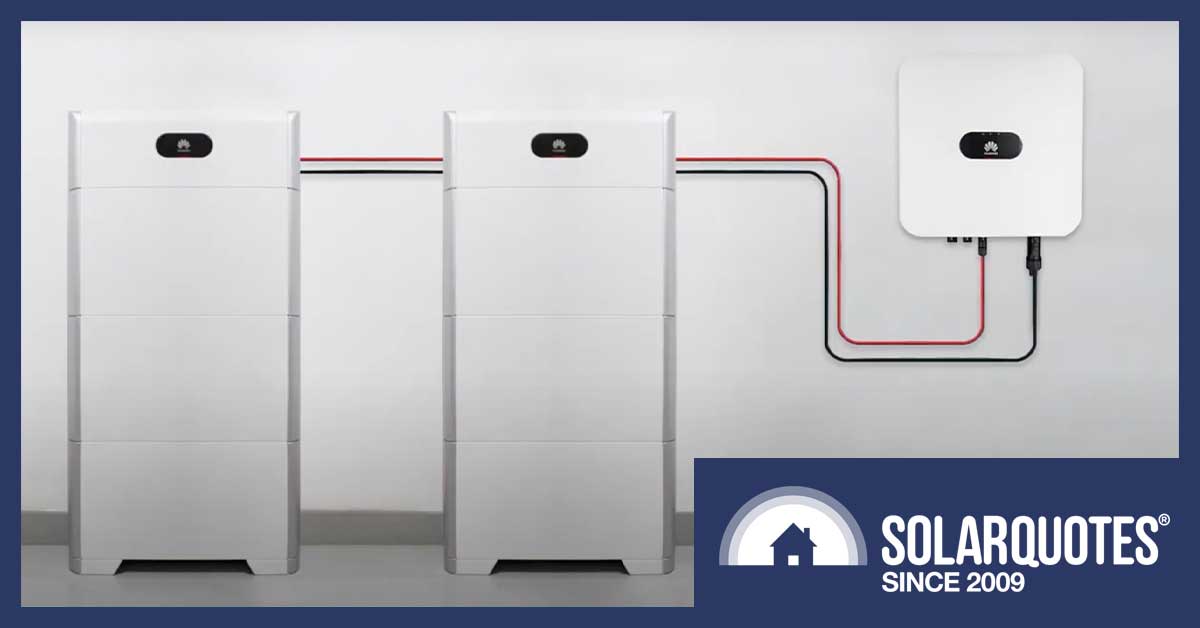
Introducing The Huawei Luna2000 Battery — A Home Battery That May Pay In WA
Huawei is the world’s largest inverter manufacturer and has been selling residential solar inverters in Australia for years. They’re now offering home energy storage with the launch of their Luna 2000 battery in May.If your solar system already has a compatible Huawei inverter it’s likely you can have a 10 kilowatt-hour version installed for under $10,000.
Some important points about the Huawei Luna2000 are:
- It’s only compatible with specific Huawei inverters.
- It has Battery Modules of 5 kilowatt-hours each. Up to six can be used for a maximum of 30 kilowatt-hours of storage.
- One Battery Module can provide 2.5 kilowatts of continuous power while two or more can provide 5 kilowatts.
- If a home starts with one or two Battery Modules it’s easy to add another in the future.
- Backup power can only be provided if a Backup Box is installed: an additional expense.
- The Backup Box can charge the Luna2000 from solar panels when the grid is down, and with an L1 Huawei inverter allows complete off-grid use.
- It’s suitable for outdoor installation but can’t be installed within 500m of the sea.
- Its warranty should last most households a full 10 years but allows battery capacity to deteriorate down to 60%.
Because Huawei has demonstrated it is capable of producing reliable electronics and because it’s a giant company unlikely to disappear any time soon — in my opinion — the Luna2000 should be a low-risk home battery purchase.
For some Western Australia homes with high evening electricity consumption, the Luna 2000 may be able to provide electricity bill savings greater than its cost within its warranty period. This is one reason why I suspect Huawei is likely to be among the major battery brands leading us into a future where solar battery storage systems are a normal household item.
It can hardly fail, considering Belinda Carlisle has a hit song about how it keeps the lights on at night:
Appearance
The Luna2000 looks pretty sexy — if you’re attracted to refrigerators:

The Huawei Luna 2000. Note I added the dimensions and weights myself because — unlike some people — I am efficient with images.
Unfortunately, for people who like things to look funky, you can’t offset the battery modules like the one on the left above. It won’t work if you do that.
As the illustration shows, a Power Module control unit sits on top of one, two or three 5-kilowatt-hour Battery Modules.
What you can’t see in the illustration above are the heavy-duty cables connecting the Luna2000 to a Huawei inverter and potentially a Backup Box as well. The picture makes things look a little too clean.
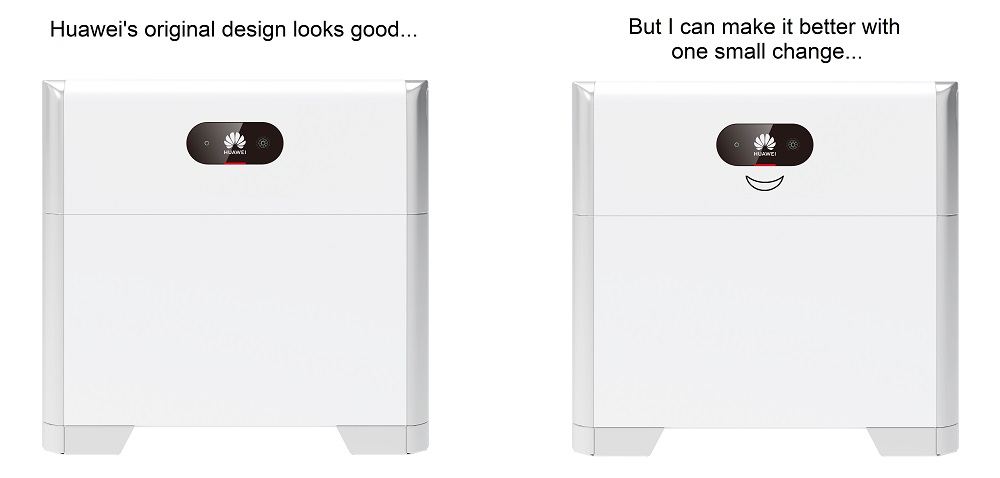
Luna 2000 Technical Specifications
Here’s an edited version of the Luna2000 datasheet showing details people are usually most interested in. The Luna is also listed on SolarQuotes’ home battery comparison table:
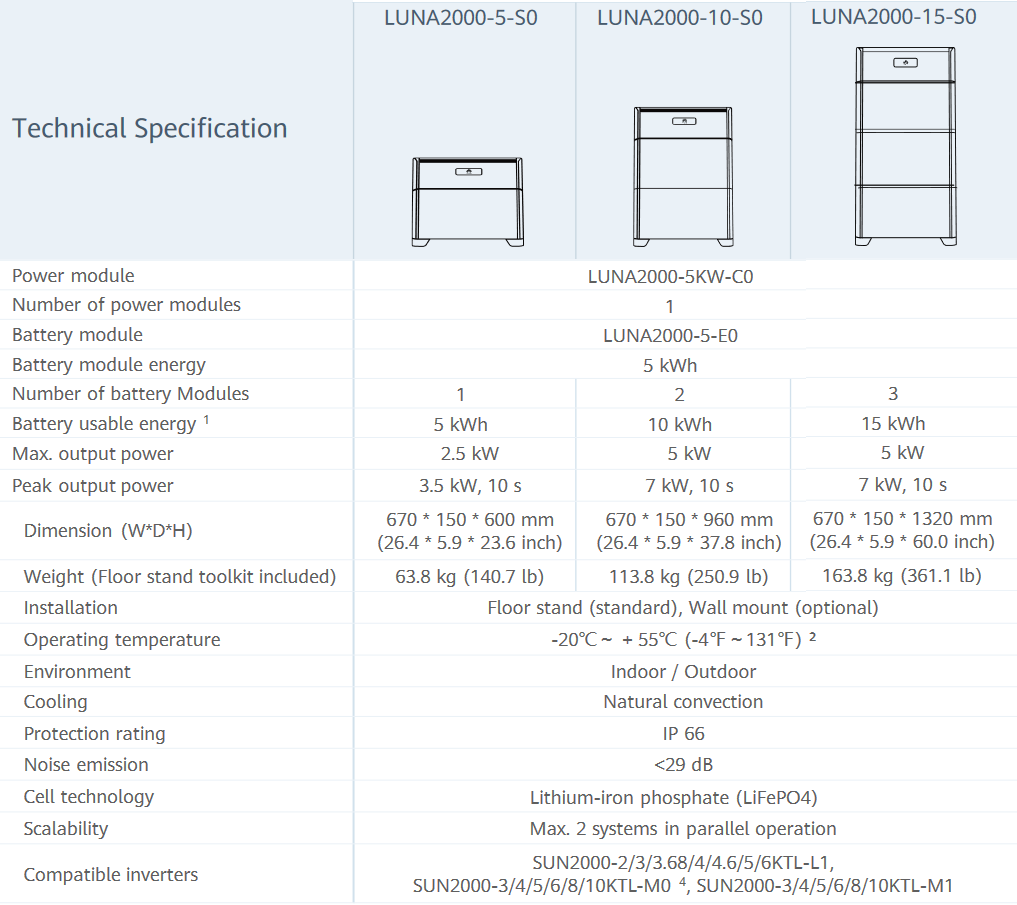
Luna Battery Chemistry
The Luna2000’s 5 kilowatt-hour Battery Modules are lithium-iron phosphate (LiFePO4). This is the most commonly used battery chemistry for stationary storage. It’s often described as the safest lithium chemistry but — as a foolhardy person who isn’t even wearing goggles shows — caution is still required:
I don’t expect the Luna2000 to catch on fire by itself, but please keep the possibility in mind whenever you throw spears at it.
If a fire does occur, this is what the installation manual says to do:

Luna Energy & Power
The Battery Modules are described as capable of 100% discharge. This is not 100% true as the module’s electronics will preserve a small amount of charge, but not having to worry about the difference between nominal and usable storage is convenient.
I’m about to tell you how much energy the solar battery can store and how much power it can provide. If you’re not clear on the difference between energy and power, here’s an explanation.
Battery Modules can be stacked up to three high and a Power Module that controls them is placed on top. When connected to a compatible inverter this gives the following energy storage capacity and continuous power output:
- 1 Battery Module = 5 kilowatt-hour of energy storage and 2.5 kilowatts of power output.
- 2 Battery Modules = 10 kilowatt-hours of energy storage and 5 kilowatts of power output.
- 3 Battery Modules = 15 kilowatt-hours of energy storage and 5 kilowatts of power output.
Note: if the inverter is under 5 kilowatts the power output will be limited by the inverter’s capacity.
If you want more than 15 kilowatt-hours of storage, two Luna2000s can be installed in parallel to provide up to 30 kilowatt-hours of storage. More modules won’t improve the power output beyond 5 kilowatts:
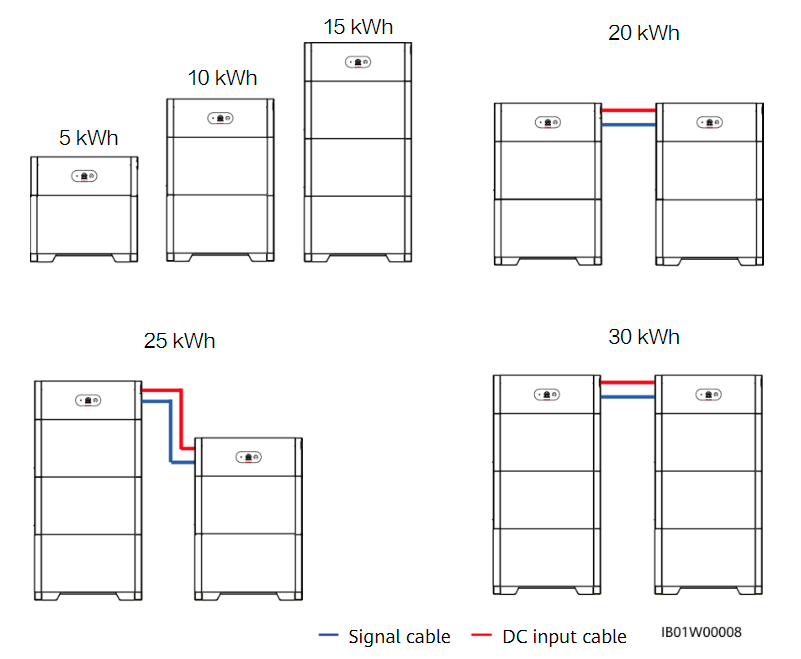
Luna2000 installation options
According to the installation manual (downloadable here), with three-phase power it’s possible to put up to 30 kilowatt-hours of battery modules on each phase for a total of 90 kilowatt-hours of storage. But you’d probably have to be a pretty big Luna 2000 fan to do that.
Easily Expandable
Each 5 kilowatt-hour Battery Module operates separately from the others. This means if a fault develops in one module the others can still be used until the defective unit is repaired or replaced – with an exception being if the fault involves flames shooting out of the module.
The independent operation makes it easy to add an extra module to expand storage capacity or compensate for capacity deteriorating over time. As each battery module is covered by its own warranty, adding a new one to an existing system won’t create a warranty issue.
Outdoors Installation Okay
The Luna2000 is water-resistant and can be installed outdoors. Its IP rating — or Ingress Protection rating — is IP66. This indicates it’s dust-tight and able to resist jets of water from all directions. This means if your idiot cousin decides to hose down your home battery, it should be fine.

IP 66 is about as good as home battery systems not owned by Aquaman get. (Image: B&R Enclosures)
While IP66 is excellent, the battery still requires installation in the shade and out of direct rain and snowfall:

The quick install guide also requires the battery to be installed away from fires and explosions, but I was hoping you could figure that out for yourself.
The Luna2000 is normally floor-mounted, but can be wall-mounted. Either way, a 10-15 cm gap between it and any adjacent wall is required. It also needs at least 30cm clearance to the top and sides. This is so air circulation can cool it. It will also need to be within 10 m of its inverter.
There are two requirements from the installation manual I will quote in full:
- “Do not install the battery in a position where it is easy to touch because the temperature of the chassis and heat sink is high when the battery is running.”
- “Children are not allowed to enter the installation position.”
This makes it sound like it can get very hot, although I doubt the battery will reach 60 ºC. At least, I hope it won’t. That’s the temperature briefly touching metal with your bare hand causes a first-degree burn. It’s also a temperature that’s very bad for lithium batteries.
The second requirement, keeping it away from children, may be difficult.
Do Not Install Within 500m Of The Sea
One requirement of the Luna2000 — similar to Huawei inverters — is it can’t be installed within 500m of the sea. This is to prevent corrosion from salt-mist that may be blown inland. In the past, Huawei has “signed off” on allowing inverters to be placed within this limit without affecting the warranty in situations where salt mist corrosion is unlikely to be a problem. For example, indoors. It’s possible they’ll do the same for batteries.
Update September 1st 2021: I’ve been informed Huawei will allow installations of the Luna2000 within 500m of the sea for indoor locations such as garages.

I appreciate the way Huawei named their solar battery to compete with the title of a 70s TV show about a moon base.
Operating Temperature
The operating temperature of the Luna 2000 is given as -20 ºC to 55 ºC. That sounds great, but checking the small print reveals it’s not the full story:
![]()
This means the Luna2000’s normal operating temperature is actually from 6 to 44 ºC. From -20 to 5 ºC and from 45 to 55 ºC the battery will still work but it will derate. This will reduce the rate at which it can charge and discharge.
Derating when temperatures are extreme is standard for lithium-ion batteries and the temperature range the Luna2000 can handle is good. Providing some power at 50 ºC is important. If it can hit 49.6 ºC in Canada it can hit 50 ºC anywhere in Australia.
To prevent damage when used during low temperatures, Battery Modules have an internal heating element that can draw 300 watts. While this would rarely activate under Australian conditions, on some cold mornings it may switch on and consume energy.
Noise
The Battery Modules and the Power Module that sits on top don’t have cooling fans. Instead, they rely on “natural convection” for cooling. This means “air”. Not having fans is useful for quiet operation and their noise emissions are given as “under 29 decibels”. A whisper is around 30 decibels, so it should be correct to say they are whisper quiet and only make a mild electronic hum.

I just wanted to show you another picture from Space:1999 because, as you can see, I played one of the characters. You can also see space was a lot more colourful in the 1970s than it is today. Possibly because of all the LDS people were taking back then.
Huawei Luna Efficiency
I haven’t found anything on the efficiency of the Luna2000 and I’ve emailed Huawei asking for information. I would expect a round trip efficiency of about 90% or less. If it was over 90% I think Huawei would have mentioned it as a selling point. Because modules have a heating element their efficiency is likely to be reduced in cold climates but, without heating, lithium batteries normally can’t be used in sub-zero temperatures.
Warranty
The warranty for the Power Module that sits on top of a Luna2000 is 10 years. For a Battery Module, it’s 10 years or until it provides 16,450 kilowatt-hours of stored energy. The warranty allows Battery Modules to deteriorate all the way down to 60% of their original capacity, which would be 3 kilowatt-hours.

16.45 MWh = 16,450 kilowatt-hours
If a 5 kilowatt-hour Battery Module provides an average of 4.5 kilowatt-hours of storage per day, then the warranty will last the full 10 years, as it won’t exceed the 16,450 kilowatt-hour limit.
If the battery develops a problem, the warranty says Huawei must be informed within two weeks. I recommend notifying the installer immediately. Don’t put it off because some things that are an easy fix if caught early can turn your solar battery into a brick if left too late.
This warranty is more or less what I expected it to be. While it allows the battery capacity to drop all the way down to 60% rather than 70% like a Tesla Powerwall 2, the Luna 2000 warranty allows for 20% more stored energy to be provided per kilowatt-hour of original capacity before the warranty kicks the bucket.
Huawei Solar has the general warranty for their inverters and Luna2000 battery on their site, but do not provide a specific warranty document for it.

This single Battery Module Luna2000 was installed by Empower Solar in Perth. A lot of effort was put into hiding the cables behind the wall, so the installation looks very neat.
Luna Compatible Inverters
Three Huawei inverters are compatible with the Luna2000 Battery:
- L1 single-phase inverters such as the SUN2000-5KTL-L1. These range from 2-6 kilowatts and are capable of full off-grid operation with the Luna2000 battery.
- M0 three-phase inverters such as the SUN2000-5KTL-M0. These range from 3-10 kilowatts. They’re not compatible with the Backup Box and so are unable to provide backup power.
- M1 three-phase inverters such as the SUN2000-5KTL-M1. Only the 5 and 6 kilowatt versions are compatible with Luna 2000. These can use the Backup Box to provide power during blackouts but don’t have an off-grid mode for complete off-grid use.
These Huawei inverters have 10 year warranties.
AC Coupling May Be Possible
If you have an existing solar system without a compatible inverter, it may be possible to use a Huawei inverter to AC couple the Luna2000 to your home. If this is done the Huawei inverter won’t have any direct connection to the solar panels. Instead of operating as a solar inverter, it will only function as a battery inverter for the Luna 2000.
This approach will require paying for an inverter and extra installation work, so it’s likely to add over $2,000 to the cost. I’m unaware of any installations in Australia that have used this approach.
Huawei Backup Box
The Backup Box is separate hardware that enables the Luna2000 to provide power during a blackout when paired with a suitable inverter. Backup power will first come from the solar panels if they’re able to provide any, and then from the Battery Modules. The Backup Box comes in two versions:
- Backup Box-B0 for use with single-phase L1 inverters such as the SUN2000-5KTL-L1. (approx $1,200 installed)
- Backup Box-B1 for use with two M1 three-phase inverters — SUN2000-5KTL-M1 and SUN2000-6KTL-M1 (approx $1,500 installed)
Backup Box-B0 + L1 inverter: This can provide up to 5 kilowatts of continuous power from a Luna2000 battery on a single phase. To have the maximum 5 kilowatts of backup power, two or more Battery Modules will be required as well as a Huawei SUN2000-5KTL-L1 or SUN2000-6KTL-L1 inverter. The L1 inverters allow the Backup Box to supply power during blackouts and are also suitable for use off-grid.
Backup Box-B1 + M1 SUN2000-5KTL-M1 and SUN2000-6KTL-M1: This can provide up to 3.3 kilowatts of continuous backup power per phase during a blackout. The total amount of power it can supply will be limited to 2.5 kilowatts with one battery module or 5 kilowatts with two or more. These inverters don’t have a full off-grid mode, so the Backup Box is presumably only for providing backup when the grid is down.
The IP rating of the Backup Box is IP65. While not as good as the IP66 of the Luna2000, this makes it resistant to dust and rain and suitable for outdoor installation.
The switchover time for the Backup Box when a blackout occurs is given as under 3 seconds. While this isn’t long, it’s more than enough time to lose progress on your computer game or blog po…

It’s very different from the seamless switchover some solar battery systems have. On the bright side — or perhaps the not at all bright side — when the lights go off it makes it obvious the grid has failed.
A weak point of the Backup Box is its specified operating temperature is -20 to 45 degrees. So in a heatwave it may not work.

The Backup Box is 40cm by 35cm and isn’t very attractive. Huawei should have copied the colour scheme and style of the Luna 2000, as Tesla did with their box full of electronic sausages. Also, if it’s reliable, it should have a warranty that reflects that.
The Backup Box Warranty Is Lousy
Huawei residential solar inverters have a 10 year warranty and the Luna2000 warranty should last most households a full 10 years. But the Backup Box warranty is only 2 years. That’s one fifth that of the hardware it’s designed to be used with, which is really dumb. A homeowner doesn’t want to have to worry about an important piece of hardware breaking down up to 8 years before the warranty on other components runs out.
I’m confident Huawei can make a Backup Box able to reliably last over 10 years, so I hope they fix this inadequate warranty soon.
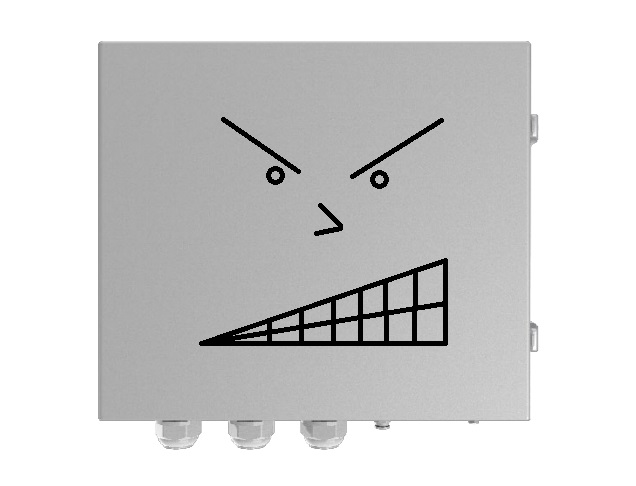
If Huawei is going to produce an ugly Backup Box, they should at least run with it and provide it with a little personality.
Huawei Can Probably Be Trusted
Whether you are getting a new rooftop solar power system or already have one with a compatible Huawei inverter, then a Luna2000 can provide solar battery storage with the following advantages:
- It should be reliable as Huawei has demonstrated it can produce durable electronics.
- It’s a huge company with deep pockets and a reputation to protect. This means it’s likely to pay for any repairs, replacements, or recalls that may be necessary during the battery’s warranty period.
- Huawei has a strong Australian presence and is unlikely to pack up operations and leave the country if one of its product lines has problems.
If you look around, I’m sure you can find solar batteries cheaper than the Luna 2000, but I doubt they’ll have these advantages. If you don’t understand why it’s a bad idea to get the cheapest solar batteries you can find, just scroll up until you come to the video of a lithium iron phosphate battery on fire.
Luna2000 Price
If you already have a solar system with a compatible Huawei inverter, the estimated installed cost of a Luna2000 is:
- 5 kilowatt-hours: under $7,000
- 10 kilowatt-hours: under $10,000
- 15 kilowatt-hours: under $13,000
If you don’t already have a suitable inverter installed and want a Luna 2000 then your options are:
- Install a solar system with a compatible Huawei inverter.
- Replace the existing inverter with a Huawei . This may cost a couple of thousand dollars. If the original installer isn’t willing or able to do this it may be difficult to find someone to do the work, as installers are often reluctant to touch installations that aren’t their own.
- Leave your existing solar power system as it is and AC couple a suitable Huawei inverter and Luna2000 battery. This approach is likely to add over $2,000 to the cost of the Luna 2000.
If you want backup — as most people do — then for a single-phase installation having a Backup Box installed is likely to add around $1,200 or more to the cost. For a three-phase installation, it may be an extra $1,500.
The Luna2000 May Pay In WA
Thanks to high electricity prices and a rock bottom feed-in tariff for new solar, Western Australia is where a Luna2000 is most likely to pay for itself through savings on electricity bills alone.
I recently determined the maximum amount a WA household can save over a year with a 10 kilowatt-hour battery is $1,600. I also explained why no normal household will actually save that much.
But it is possible for a solar battery to save half that amount. This means a 10 kilowatt-hour Luna2000 would only have to last a couple of years beyond its warranty to pay for itself. For some households the savings could be even higher, allowing the home battery to pay for itself within its warranty period. This would make it a fairly safe investment, because I doubt Huawei will disappear any time soon and not be around to provide warranty support.
Many households don’t have a high enough evening electricity consumption to make a 10 kilowatt-hour solar battery worthwhile, but they may find the 5 kilowatt-hour Luna 2000 can pay for itself because it’s easier to fully charge with solar electricity during the day and easier to use all the stored energy during peak periods on a time-of-use tariff. Because the Luna2000 is modular, a household could start with 5 kilowatt-hours and later, easily expand it to 10 kilowatt-hours.
A Luna2000 Future?
The Luna 2000 is not the only home battery with the potential to pay for itself in places like Perth. But it is one of the few from a large manufacturer which has…
- Enough experience with batteries and electronics to get it right and build a reliable battery system.
- A high probability of still being around to fix problems if they manage to screw up the previous point.
For these reasons, I think the Luna2000 is a strong contender to lead Australia into a future where solar batteries are a standard household item — starting in WA.

 RSS - Posts
RSS - Posts



I note in passing that you STILL refuse to accept that there is absolutely NO reason to use an inverter in a house-application at all. NONE. NIL. NADA. DC power is CHEAPER (no inverter is ONE great saving, and storage is MUCH cheaper, much MORE EFFICIENT (which is why they’re used in space vehicles, mobile phones and heart-pacemakers, ALL motor vehicles including trams and trains,none of which in fact WILL NOT run on AC) and SAFER in any respect. (A mate of mine from the early off-grid days burnt his solar-powered house down when an inverter, needed to run a power-tool shorted, melted and burst into flames. But he DID save $80 by not buying a DC-powered tool!
Hereby a challenge that YOU explain why people should bother with AC (aka AC for ‘Alternating CURRENCY!) at all. I dare you to engage in a non-profit debate on the issue. Game?
An excellent report Ron – thank you.
Lawrence Coomber
Spot on report Ron, although I have doubts about a single 5kWh module being that useful as it only provides 2.5kW of power or about 0.5C. That’s an electric kettle and not much else.
I fail to see how at $1,000/kWh this battery is “Tantalisingly Close To Paying For Itself”. It’s not even in the ballpark, let alone the same orbit as being able to pay for itself.
Only in WA:
https://www.solarquotes.com.au/blog/tou-solar-batteries-savings/
I read it. Even your “40%” figure is optimistic.
I’m not a pessimist, just a realist. It’s just not even close to achieving a sensible payback, let alone tantalisingly.
Hi Ronald
This article says 10KW Luna installed for under $10,000.
Is that with the smart meter and wall bracket?
Can you tell me which company installs this battery for under $10,000 in Perth?
Hi David
The price given was for a 10 kilowatt-hour Luna2000 for a home with an existing suitable Huawei inverter and smart meter. It includes the wall bracket, but note if you want an installation like the photo in the article where all the wiring is hidden that is likely to increase the price. The article was written one year ago, so prices may have changed since then. Home battery prices have tended to increase over the past year due to higher commodity costs including record prices for lithium. I don’t know what their prices are like now, but two businesses installing Luna200s in Perth are Solar4Ever and Empower Solar Perth.
Imagine the cost of 50Kw EVs if manufacturers charged $1,000 per Kw.
Musk has been funding his space adventures by doing Just that.
Alex you have drifted off topic!
The topic is Global Renewable Energy and Battery Storage Technology Innovation. That’s it.
Why on earth would you suggest that anybody in the world would be remotely interested in your alternative topic of: The Commercial Viability or Other of Global Renewable Energy and Battery Storage Technology?
Shame on you Alex.
Lawrence Coomber
Hello Ronald and everyone following. I must admit the article got my interest going with the hope of one day soon achieving our exit (bar supply charges :)) from the leach pool.
I have Huawei SUN200L-KTL. Installed almost 2 years ago along with 6.6 worth of panels. Upon reading Your scholarly article Ronald I contacted the supplier/installer to find out his thoughts on the matter.
His opinion remains that the time is yet to come! Also interestingly he has gone off using Huawei because of lack of (no) back up on old models, (mine at 2 years is considered an old model.) he said there are now better options in the market in inverters and batteries particularly considering his previous observation.
Ps: I might add we have room on our roof comfortably for another 20 or more panels and our thoughts are as we gracefully grow older ourselves we may invest in an EV, say the next 5 years or so(?). Oh also the model is Huawei SUN2000-5KTL.
Hi Michael, the SUN2000-5KTL (1ST GEN) isn’t compatible with LUNA. Ask your installer to contact Huawei AU team, as there will be a promotion for free inverter upgrades to L1 if LUNA i(min 10kwh) is being bought.
Good of Huawei to consider free inverter upgrades fir battery capability. I wonder if the old inverters not being supported with the LUNA battery is why the installer mentioned in the comments above us moving away from them?
Really interesting article, thanks! I have the sun2000-6KTL-L1 with just a single 5kW battery so far. The power module consumes about 140 watts, which is more than expected. The battery will automatically charge to 100% when there’s a power outage even without a backup box.
I find the passively-cooled inverter heats up too much and quickly thermally throttles, it seems to max out at about 4.5kWh on a sunny day which means I am wasting a lot of PV power, my previous Trannergy inverter thermally throttled to about 5.5kW, so I’m losing an entire extra kilowatt on hot sunny days on my 6.1kW PVs. I now have two fans in place to try and cool it down. My Trannergy used to briefly peak at 6.1, but I haven’t seen the Huawei getting close to that yet. The app is terrible, with very little detail given, I can’t seem to find the inverter temperature or even the individual wattage of each string. I expected a lot more coding prowess from Huawei, but I unhappily give it a 1 out of 5 rating.
please, share the installation link for sun2000 5ktl on luna2000 single battery
If you’d like quotes from installers we know do excellent work because they’ve been vetted by my boss, Finn, you can follow this link:
https://www.solarquotes.com.au/quote/start/
Enter your postcode and click on “solar + batteries” and answer the questions that come up as best you can. Note that you are interested in a Luna2000.
Really enjoy the analysis, I check it frequently for when it turns the corner. I have a question that I am unsure, thought I had read something at some point but struggled to ever find it again. Given that the inverter ‘shapes’ the ac output contribution above the inverter rating (in my example I have a three phase Huawei Sun2000-5ktl-mo which shapes at 5.5kw and I have 6.6kw panels on the roof). All the above equations being what they are is there some potential value I can unlock with a Luna battery given the inverter can divert some of the DC strings supply generation into the Luna battery which is overwise just ‘throttled’ and therefore lost by the inverter function. I have western facing panels and so my daily summer production is say 42kw. Could I unlock this generation above the shaped amount of another 5kw/h or so (not knowing what this is but a rough look at my graphs)? Some smart software to capture this only to the battery (system size dependent) and tou tariffs would help if of course possible. If so this could help with economics given the general oversizing of systems at least in Western Australia. If I could attach a picture would probably be easy to show but hopefully you get my query.
If of course if I have just not interpreted the article and it’s in there my apologies. If there is a functional hardware limitation also I do wonder if this is an improvement for future.
There is potential for hybrid inverters to supply their full continuous AC output while still supplying additional DC power to batteries. For a typical residential installation where panel capacity is a maximum of 133% of inverter capacity there won’t be a lot of benefit as the total amount of energy lost to “clipping” is usually very small. But every bit helps and it is possible to have panel capacity that is over 133% of inverter capacity.
I don’t think there is any software fix a homeowner could use, but it is in hybrid inverter manufacturer’s interest to include this ability, where possible, as it would make their product more desirable.
Hi, great article! I am very interested to upgrade my setup (4,5 kWp and SUN2000-5KTL-L1 inverter) with the Luna2000 (10 or 15 kWh setup). Now, I am a bit confused about the Backup Box that would be needed when blackout occurs? Would the inverter not run from the connected Luna2000?
I am obviously not an installer or expert myself: can anyone explain me the workings with and without a Backup Box in my setup (and if I need it or not?)
Thanks!
Hi Roel
A backup box may add $1,200 or more to the cost of a Luna2000 installation and can provide 5 kilowatts of continuous power. To get this much power out of it you will need 2 or more 5 kilowatt-hour battery modules. Five kilowatts is enough to meed normal household needs during a blackout but it will still be necessary to be careful with consumption.
The backup box is required because it is necessary for the home to be disconnected from the grid before the battery supplies power to the home during a blackout and the backup box makes this possible.
“Backup Box-B1 + M1 SUN2000-5KTL-M1 and SUN2000-6KTL-M1: This can provide up to 3.3 kilowatts of continuous backup power per phase during a blackout. The total amount of power it can supply will be limited to 2.5 kilowatts with one battery module, or 5 kilowatts with two or more.”
No, it doesn’t. The Backup Box-B1 only provides backup output on a single phase, and up to 3.3 kilowatts on that one phase. If you don’t believe me, check here: https://solar.huawei.com/-/media/Solar/attachment/pdf/eu/datasheet/backup-box.pdf
Whatever you do, don’t make the same mistake we did and spend $28k on a new solar system with 3-phase Huawei inverters, battery and backup box only to find you need to pay a solar electrician thousands more because it won’t back up 3-phase. Go with one of the other brands out there that will actually back up 3-phase when the grid goes down.
Good comprehensive review of the official specs and on paper this system is a great choice – which is why I got it myself, for two homes.
The reality though is somewhat different from the theory.
The battery modules (not their DC-DC inverter) can be rather noisy, making all sorts of noises including in the worst case a very high pitched sound. These noises often persist even when there is no charging or discharging going on. Huawei denies this is a fault and it is extremely hard to convince them to exchange a particularly noisy module. So the batteries should be kept in a place where they are closed off from the living area of a house. And while Huawei says they are fine for outdoors, they are clearly not made to last when exposed to the elements, putting aside the risk of theft (they are fairly easy to dismantle and remove).
Like with any batteries, life expectancy will depend on how they are used. The faster the charging and discharging, the more often they are fully charged or fully emptied, the faster they will deterioate, even if this deterioation is slower than for a Li-Ion battery. As such one would like to manage these factors, especially on days when not the full capacity is needed. Alas the Huawei Fusion Solar app allows no such control, and making changes to the charging and discharging is possible only via the web interfaces. There you can set some charging limits, though they themselves are crude, so for example the max must be between 90 and 100%, the minimum between 0 and 20%. One wished the max could be set lower when there is no need to go to 90%. And ideally this could all be automated by linking it to the weather forecast, something some other manufacturers offer already. So if you want to limit charging more than necessary, you need to log in frequently and just manually control the charging. This is a pain.
[Previous comment continued]
The inverter controlling the battery has the nice feature of being able to charge the battery with any power coming from the modules that is in excess of what it can invert to AC. This means that even when overpowering the system by having greater module capacity than AC inverter capacity you can actually harvest all this excess capacity rather than letting it go to waste. But works only if the battery still has charging capacity left. However there is no way to control this automatically and in fact, if you let the battery be charged from the moment it becomes bright (which is so by default unless you manually stop charging altogether), the battery is likely be full by the time you would want it to harvest the excess production during midday. So without a setting that can actually control charging in a smart way, this nice feature is pretty useless.
The inverters are not fool-proof either. They will sometimes struggle to set inversion to right under their capacity limit when panel output exceeds the limit, and settle 10-15% below the limit. This makes a mockery of the 97% conversion efficiency claim when a much bigger portion of the power doesn’t even make it into the inversion. On other occasions the inverters fail to boot a string and sometimes even both strings and therefore themselves. This usually happens in the early morning and results in the loss of half of the inverter power for that day. The next morning the inverter has reset itself and works fine again. However, if both strings happen to fail, only a manual complete reset of the inverter will bring it back to life.
Huawei is a terrible company to deal with any quality issues. Their general stance is to deny the issue and to blame the customer or installer and refuse to take any responsibility, even when it is clearly proven they are at fault. So when you choose them, just be aware that you may need to deal with any issues on your own.
Thanks for the very useful review and discussion. My installer refuses to install the Backup Box-B0 because of “bad performance” here in Spain. Has anyone reviewed this or any experience? My system runs off a SUN2000-3KTL-L1
Hi,
What is the minimum you can safely set the battery backup at please as I want to utilise it as much as possible. I understand the battery is usually set to stop at 20% as a backup which seems a lot of wasted power/ savings potential.
Many thanks
Luke
Hello
i read your review with interest, but I must take issue with the noise emitted from the battery unit.- mine emits a humming, high frequency whine, of between 45 and 50 decbels, for a period of about ten minutes, usually at around 06:45 am and occasionally at other times.
Needless to say, because my unit is installed in a utility room, inside my home, this humming wakes the entire houshold.
I am in contact with Huawei Europe regardling this issue, but their customer service is being unhelpful, bordering on the defensive.
Therefore, I would wish to warn ant potential purchaser of this potential issue and certainly, would not recommend the Luna2000 be installed inside a home – it should be sited outside, or in garages only.
Huawei do not, in any of their literature mention this probelm, so be warned.